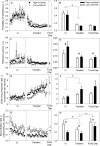The isolation of motivational, motoric, and schedule effects on operant performance: a modeling approach
- PMID: 21765544
- PMCID: PMC3136892
- DOI: 10.1901/jeab.2011.96-17
The isolation of motivational, motoric, and schedule effects on operant performance: a modeling approach
Abstract
Dissociating motoric and motivational effects of pharmacological manipulations on operant behavior is a substantial challenge. To address this problem, we applied a response-bout analysis to data from rats trained to lever press for sucrose on variable-interval (VI) schedules of reinforcement. Motoric, motivational, and schedule factors (effort requirement, deprivation level, and schedule requirements, respectively) were manipulated. Bout analysis found that interresponse times (IRTs) were described by a mixture of two exponential distributions, one characterizing IRTs within response bouts, another characterizing intervals between bouts. Increasing effort requirement lengthened the shortest IRT (the refractory period between responses). Adding a ratio requirement increased the length and density of response bouts. Both manipulations also decreased the bout-initiation rate. In contrast, food deprivation only increased the bout-initiation rate. Changes in the distribution of IRTs over time showed that responses during extinction were also emitted in bouts, and that the decrease in response rate was primarily due to progressively longer intervals between bouts. Taken together, these results suggest that changes in the refractory period indicate motoric effects, whereas selective alterations in bout initiation rate indicate incentive-motivational effects. These findings support the use of response-bout analyses to identify the influence of pharmacological manipulations on processes underlying operant performance.
Keywords: bouts; effort; extinction; lever press; motivation; rats; tandem ratio.
Figures






Similar articles
-
About bouts: A heterogeneous tandem schedule of reinforcement reveals dissociable components of operant behavior in Fischer rats.J Exp Psychol Anim Learn Cogn. 2017 Jul;43(3):280-294. doi: 10.1037/xan0000144. J Exp Psychol Anim Learn Cogn. 2017. PMID: 29120215
-
The effect of lever height on the microstructure of operant behavior.Behav Processes. 2017 Jul;140:181-189. doi: 10.1016/j.beproc.2017.05.002. Epub 2017 May 10. Behav Processes. 2017. PMID: 28499811
-
The distribution of response bout lengths and its sensitivity to differential reinforcement.J Exp Anal Behav. 2015 Sep;104(2):167-85. doi: 10.1002/jeab.168. J Exp Anal Behav. 2015. PMID: 26377437
-
Longer operant lever-press duration requirements induce fewer but longer response bouts in rats.Learn Behav. 2021 Sep;49(3):330-342. doi: 10.3758/s13420-021-00464-7. Epub 2021 Feb 24. Learn Behav. 2021. PMID: 33629243
-
Theory of reinforcement schedules.J Exp Anal Behav. 2023 Nov;120(3):289-319. doi: 10.1002/jeab.880. Epub 2023 Sep 14. J Exp Anal Behav. 2023. PMID: 37706228 Review.
Cited by
-
Prior experience modifies acquisition trajectories via response-strategy sampling.Anim Cogn. 2023 Jul;26(4):1217-1239. doi: 10.1007/s10071-023-01769-y. Epub 2023 Apr 10. Anim Cogn. 2023. PMID: 37036556 Free PMC article.
-
Simulating bout-and-pause patterns with reinforcement learning.PLoS One. 2020 Nov 12;15(11):e0242201. doi: 10.1371/journal.pone.0242201. eCollection 2020. PLoS One. 2020. PMID: 33180864 Free PMC article.
-
The temporal structure of goal-directed and habitual operant behavior.J Exp Anal Behav. 2024 Jan;121(1):38-51. doi: 10.1002/jeab.896. Epub 2023 Dec 22. J Exp Anal Behav. 2024. PMID: 38131488 Free PMC article.
-
Extinction learning deficit in a rodent model of attention-deficit hyperactivity disorder.Behav Brain Funct. 2012 Dec 13;8:59. doi: 10.1186/1744-9081-8-59. Behav Brain Funct. 2012. PMID: 23237608 Free PMC article.
-
Characterizing operant hyperactivity in the Spontaneously Hypertensive Rat.Behav Brain Funct. 2012 Jan 26;8:5. doi: 10.1186/1744-9081-8-5. Behav Brain Funct. 2012. PMID: 22277367 Free PMC article.
References
-
- Adair E.R, Wright B.A. Behavioral thermoregulation in the squirrel monkey when response effort is varied. Journal of Comparative and Physiological Psychology. 1976;90:179–184. - PubMed
-
- Anderson D.R, Burnham K.P. Avoiding pitfalls when using information-theoretic methods. Journal of Wildlife Management. 2002;66:912–918.
Publication types
MeSH terms
Grants and funding
LinkOut - more resources
Full Text Sources

